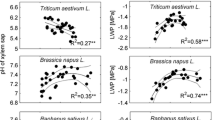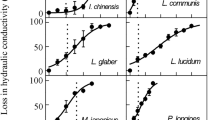Abstract
The objective of this study was to determine how adjustment in stomatal conductance (g s) and turgor loss point (Ψtlp) between riparian (wet) and neighboring slope (dry) populations of Acer grandidentum Nutt. was associated with the susceptibility of root versus stem xylem to embolism. Over two summers of study (1993–1994), the slope site had substantially lower xylem pressures (Ψpx) and g s than the riparian site, particularly during the drought year of 1994. The Ψtlp was also lower at the slope (-2.9±0.1 MPa; all errors 95% confidence limits) than at riparian sites (-1.9±0.2 MPa); but it did not drop in response to the 1994 drought. Stem xylem did not differ in vulnerability to embolism between sites. Although slope-site stems lost a greater percentage of hydraulic conductance to embolism than riparian stems during the 1994 drought (46±11% versus 27±3%), they still maintained a safety margin of at least 1.7 MPa between midday Ψpx and the critical pressure triggering catastrophic xylem embolism (ΨpxCT). Root xylem was more susceptible to embolism than stem xylem, and there were significant differences between sites: riparian roots were completely cavitated at -1.75 MPa, compared with -2.75 MPa for slope roots. Vulnerability to embolism was related to pore sizes in intervessel pit membranes and bore no simple relationship to vessel diameter. Safety margins from ΨpxCT averaged less than 0.6 MPa in roots at both the riparian and slope sites. Minimal safety margins at the slope site during the drought of 1994 may have led to the almost complete closure of stomata (g s=9±2 versus 79±15 mmol m-2 s-1 at riparian site) and made any further osmotic adjustment of Ψtlp non-adaptive. Embolism in roots was at least partially reversed after fall rains. Although catastrophic embolism in roots may limit the minimum Ψ for gas exchange, partial (and reversible) root embolism may be adaptive in limiting water use as soil water is exhausted.
Similar content being viewed by others
References
Cochard H, Breda N, Granier G, Aussenac G (1992a) Vulnerability to air embolism of three European oak species (Quercus petraea (Matt) Liebl., Q. pubescens Willd., Q. robur L.). Ann Sci For 49:225–233
Cochard H, Cruiziat P, Tyree MT (1992b) Use of positive pressures to establish vulnerability curves. Plant Physiol 100:205–209
Crombie DS, Hipkins HF, Milburn JA (1985) Gas penetration of pit membranes in the xylem of Rhododendron as the cause of acoustically detectable sap cavitation. Aust J Plant Physiol 12: 445–453
Dina SD (1970) An evaluation of physiological response to water stress as a factor influencing the distribution of six woody species in Red Butte Canyon, Utah. PhD Thesis, University of Utah, Salt Lake City
Jarbeau JA, Ewers FW, Davis SD (1994) The mechanism of water stress-induced embolism in two species of chaparral shrubs. Plant Cell Environ 18:189–196
Jones HG (1990) Physiological aspects of the control of water status in horticultural crops. Hort Sci 25:19–26
Jones HG, Sutherland RA (1991) Stomatal control of xylem embolism. Plant Cell Environ 14:607–612
McDermitt DK (1990) Sources of error in the estimation of stomatal conductance and transpiration from porometer data. Hort Sci 25:1538–1548
Meinzer FC (1993) Stomatal control of transpiration. Trends Ecol Evol 8:289–294
Meinzer FC, Grantz DG (1990) Stomatal and hydraulic conductance in growing sugarcane: stomatal adjustment to water transport capacity. Plant Cell Environ 13:383–388
Morgan JM (1984) Osmoregulation and water stress in higher plants. Annu Rev Plant Physiol 35:299–319
Nobel PS, North GB (1993) Rectifier-like behaviour of root-soil systems: new insights from desert succulents. In: Smith JAC, Griffiths H (eds) Water deficits, Bros, Oxford, pp 163–176
Ritchie GA, Hinckley TM (1975) The pressure chamber as an instrument for ecological research. Adv Ecol Res 9:165–254
Saliendra NZ, Sperry JS, Comstock JP (1995) Influence of leaf water status on stomatal response to humidity, hydraulic conductance, and soil drought in Betula occidentalis. Planta 196:357–366
Schulte PJ, Hinckley TM (1985) A comparison of pressure-volume curve data analysis techniques. J Exp Bot 36:1590–1602
Sperry JS (1986) Relationship of xylem embolism to xylem pressure potential, stomatal closure, and shoot morphology in the palm Rhapis excelsa. Plant Physiol 80:110–116
Sperry JS, Saliendra NZ (1994) Intra- and inter-plant variation in xylem cavitation in Betula occidentalis. Plant Cell Environ 17: 1233–1241
Sperry JS, Tyree MT (1990) Water stress induced xylem embolism in three species of conifers. Plant Cell Environ 13:427–436
Sperry JS, Donnelly JR, Tyree MT (1988) A method for measuring hydraulic conductivity and embolism in xylem. Plant Cell Environ 11:35–40
Sperry JS, Perry A, Sullivan JEM (1991) Pit membrane degradation and air-embolism formation in ageing xylem vessels of Populus tremuloides Michx. J Exp Bot 42:1399–1406
Sperry JS, Alder NN, Eastlack SE (1993) The effect of reduced hydraulic conductance on stomatal conductance and xylem cavitation. J Exp Bot 44:1075–1082
Sperry JS, Nichols KL, Sullivan JEM, Eastlack SE (1994) Xylem embolism in ring-porous, diffuse-porous, and coniferous trees of northern Utah and interior Alaska. Ecology 75:1736–1752
Turner NC, Jones MM (1980) Turgor maintenance by osmotic adjustment: a review and evaluation. In: Turner NC, Kramer PJ (eds) Adaptation of plants to water and high temperature stress. Wiley, New York, pp 87–103
Tyree MT, Dixon MA (1986) Water stress induced cavitation and embolism in some woody plants. Physiol Plant 66:397–405
Tyree MT, Sperry JS (1988) Do woody plants operate near the point of catastrophic xylem dysfunction caused by dynamic water stress? Answers from a model. Plant Physiol 88:574–580
Tyree MT, Cochard H, Cruziat P, Sinclair B, Ameglio T (1993) Drought-induced leaf shedding in walnut: evidence for vulnerability segmentation. Plant Cell Environ 16:879–882
Tyree MT, Davis SD, Cochard H (1994) Biophysical perspectives of xylem evolution: is there a tradeoff of hydraulic efficiency for vulnerability to dysfunction? Int Assoc Wood Anat J 15: 335–360
Zimmermann MH (1983) Xylem structure and the ascent of sap. Springer, Heidelberg Berlin New York
Zimmermann MH, Potter D (1982) Vessel-length distribution in branches, stem and roots of Acer rubrum L. Int Assoc Wood Anat Bull 3:103–109
Author information
Authors and Affiliations
Rights and permissions
About this article
Cite this article
Alder, N.N., Sperry, J.S. & Pockman, W.T. Root and stem xylem embolism, stomatal conductance, and leaf turgor in Acer grandidentatum populations along a soil moisture gradient. Oecologia 105, 293–301 (1996). https://doi.org/10.1007/BF00328731
Received:
Accepted:
Issue Date:
DOI: https://doi.org/10.1007/BF00328731




